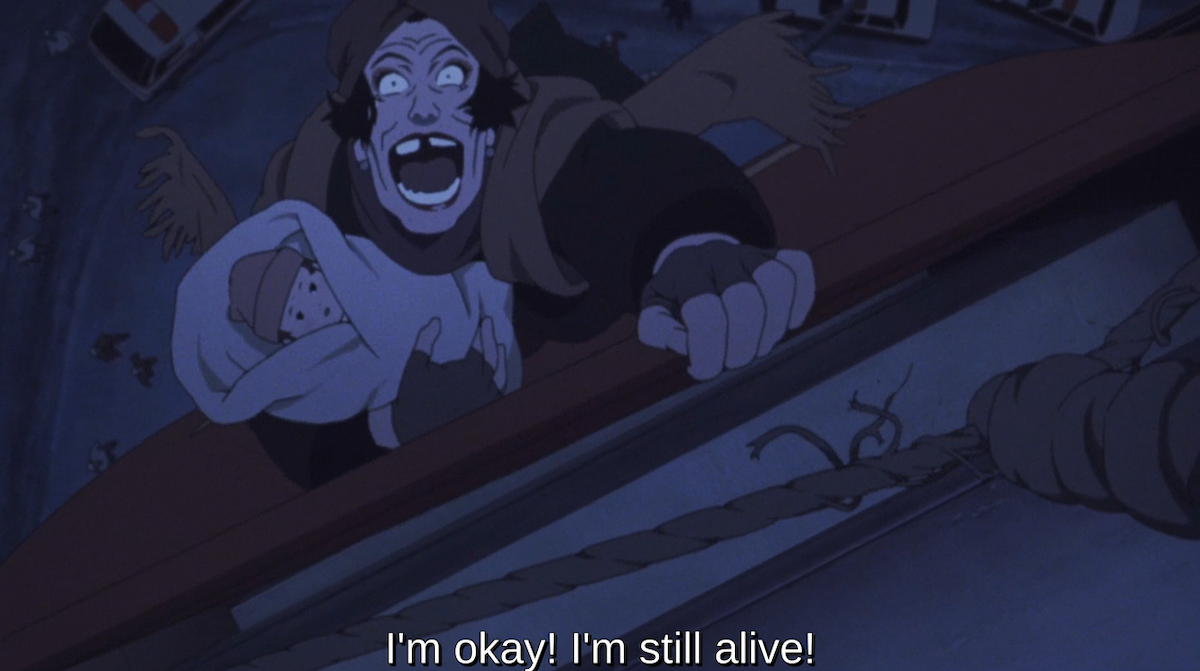TOKYO GODFATHERS (2003)
One of the best parts of watching movies is finding a director you really vibe with. It opens the door to exploring the rest of their filmography, learning what themes repeat, and how they tell a story. And there is no better example in my life than Satoshi Kon. I was first introduced to his masterpiece PAPRIKA and hungrily sought out more. Many of his films use fantastical elements, but TOKYO GODFATHERS is more down-to-earth. These are everyday miracles, the coincidences that remind us that the world isn’t as big as it appears.
Kon died in 2010, leaving behind a limited but impactful library of works that will continue to inspire artists for generations. Additionally, and unfortunately, Keiko Nobumoto, who helped write TOKYO GODFATHERS’ screenplay, died on December 10, 2021 from esophageal cancer. It feels fitting to look back on the beautiful film she helped create.
It’s Christmas Eve in Tokyo. Shoppers are getting last-minute gifts, children are caroling, and snow is steadily falling. It’s a time for family and togetherness, for letting go of past mistakes, and being thankful for what we have.
We’re introduced to our main trio: Gin, an alcoholic; Hana, a transgender woman; and Miyuki, teen runaway.
The three have become a sort of family through their struggles with homelessness together. While dumpster-diving they come across an abandoned baby with only a key and a note from a woman named Sachiko asking to take care of the kid. This makeshift family name the infant Kiyoko (a nod to “Silent Night”, which children were singing nearby at the time) and become determined to return the babe to her parents, setting off on a wild adventure that will include a shootout, a car chase, and jumping off a roof in spectacular fashion.
Even though Tokyo has a population of over ten million people, the group keeps stumbling upon strangers who, in one way or another, know who they’re looking for. A yakuza boss comically trapped under his car takes them to a club where Kiyoko’s mom used to work.
The desire for this child to have a home, a family—something that Gin, Hana, and Miyuki have lost—spurs them onwards, despite the abuse they get for vagrancy.
They’re kicked out of stores and Gin is even beaten with a metal pipe by a gang of teenagers. It’s nearly impossible to climb out of a hole if people keep pushing you further in.
Something that’s always stuck with me is the positive portrayal of Hana and her identity as a trans woman.
Japan is not known as a very LGBTQ+ friendly country (although things have gotten better over the years) so to see someone like Hana—a kind, compassionate, strong, spiritual woman who holds it together even through daily hardships—is awe-inspiring.
TOKYO GODFATHERS got a new English dub in 2019 with Shakina Nayfack, a transgender actress, voicing Hana. That is a rare win for representation and means so much to so many people.
Satoshi Kon knew how to mix comedy and tragedy so that neither becomes the sole focus. There are a lot of silly moments in this film, but they never take you out of the story. They break up the seriousness of the situation and show how people are not one-dimensional. In that way, it’s more realistic rather than adhering to the tents of one genre or even a solitary mood.
As the story progresses, we learn how each character came to live on the streets. Gin left his home voluntarily out of shame for his debts. Dishonouring his family is a deep hurt that leads him to alcohol. Hana was fired for attacking a drunk and transphobic customer and later lost her boyfriend in a tragic accident. Miyuki stabbed her father after years of emotional abuse, while her mother only stood back and watched. Each is given the opportunity to reconnect with their family through the coincidences that lead them along the path to Sachiko. It doesn’t downplay the reality of these negative events, but opens the door to healing from them.
When the trio finally arrives at a hospital, they find who they think is Kiyoko’s mother, Sachiko. After giving birth to a stillborn she was overcome with grief and stole the baby from the hospital. Going through the unthinkable has left her detached and confused; she clearly isn’t thinking straight when she steals a delivery truck and leads them on a car chase that eventually ends with Sachiko crashing into an apartment building.
Kon’s animation style used by his teams gives everyone such expressive faces and it makes the scene on the rooftop gut-wrenching as Sachiko believes she is unforgivable and goes to jump, only to be grabbed by Miyuki. In the struggle, she drops Kiyoko and Hana runs down the building like Spider-Man to save the baby. She clings on to a banner that tumbles through the sky before being picked up by what appears to be a divine gust of wind, with the light of the sun illuminating the duo as they safely fall to the ground below.
It’s a subtle hint that, maybe, there’s been a higher power guiding them in the right direction. Hana, as the most devout of the group, feels appropriately rewarded for her selfless act.
To me, it shows that everyone can make a difference, no matter how unimportant we may feel we are. The world is more connected than ever with social media and online classes as quarantines the world over continue. A kind word or a message to someone you haven’t spoken to in a while could really make their day.








